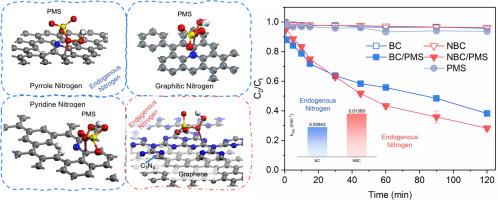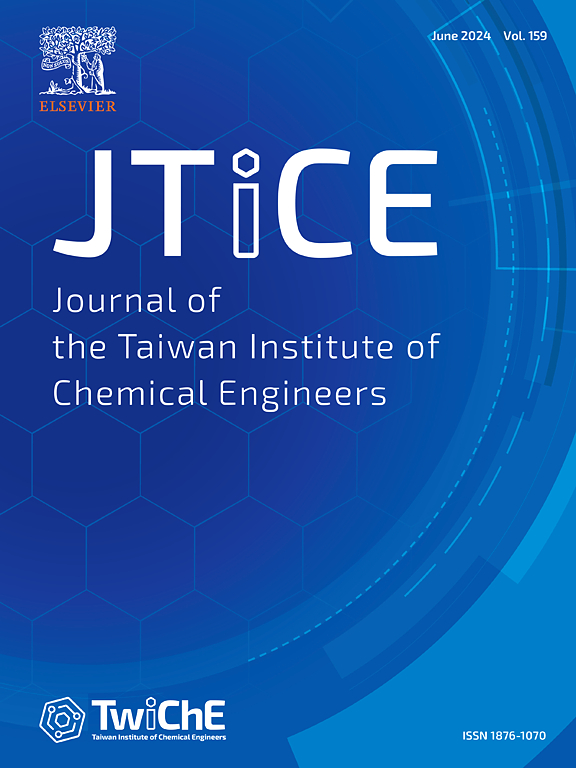掺氮碳催化剂在活化 PMS 过程中的内源氮和外源氮比较
IF 5.5
3区 工程技术
Q1 ENGINEERING, CHEMICAL
Journal of the Taiwan Institute of Chemical Engineers
Pub Date : 2024-10-05
DOI:10.1016/j.jtice.2024.105793
引用次数: 0
摘要
背景事实证明,基于硫酸根(SO4--)的高级氧化工艺(AOPs)在降解废水中的有机物方面非常有效。碳基材料已成为一种很有前景的催化剂,可活化过硫酸盐,生成环境友好的硫酸根(SO4--),达到修复目的。氮掺杂技术是一种有效的定点调节方法,可显著提高碳基催化剂的性能,从而促进碳基催化剂在未来的应用。内源和外源氮源可为氮掺杂提供氮源。然而,关于这两种掺氮生物炭的结构和催化机理比较的报道却很少。方法本文以富含天然含氮蛋白质成分的大豆为前驱体材料,制备了内源掺氮生物炭(BC)。重要发现XRD和HRTEM表征表明,在NBC中形成了g-C3N4。催化降解和淬灭实验结果表明,外源掺氮催化剂的性能优于内源掺氮催化剂。BC/PMS体系的OFL去除率高于BC/PMS体系(71.68% vs. 61.83%)。NBC/PMS 中的 kobs 也高于 BC/PMS 中的 kobs(0.00943 min-1 vs. 0.01369 min-1)。在实际应用中,NBC 是一种很有前景的 PMS 活化催化剂。DFT 结果表明,在 g-C3N4/ 石墨烯双层结构中,外源氮生成的 g-C3N4 可以提高 PMS 的活化性能。对周围碳材料电荷分布的影响使得内源氮掺杂成为在缺乏天然氮成分的情况下优化材料局部性能的良好选择。本文章由计算机程序翻译,如有差异,请以英文原文为准。

Comparison between endogenous and exogenous nitrogen of nitrogen-doped carbon catalyst in the process of activating PMS
Background
Advanced oxidation processes (AOPs) based on sulfate radicals (SO4•–) have proven to be highly effective in degrading organics in wastewater. Carbon-based materials have emerged as promising catalysts for activating persulfate, which generates environmentally friendly sulfate radicals (SO4•–), for remediation purposes. The nitrogen doping technique is an effective method for site-specific regulation and can significantly enhance the performance of carbon-based catalysts, which could promote the application of carbon-based catalysts in the future. Endogenous and exogenous nitrogen sources can provide nitrogen sources for N doping. However, there are few reports on the comparison of the structure and catalytic mechanism of these two types of N-doped biochar. It is also of great significance to reveal the mechanisms of constructing catalytic sites using endogenous and exogenous nitrogen.
Methods
Herein, the preparation of endogenous nitrogen-doped biochar (BC) was achieved by using soybean as the precursor material, which is rich in natural nitrogen-containing components of proteins. Subsequently, the BC was doped by mixing it with urea and pyrolysis, resulting in the preparation of exogenous nitrogen-doped biochar (NBC).
Significant findings
The characterization of XRD and HRTEM showed that g-C3N4 formed in NBC. The results of catalytic degradation and quenching experiments demonstrate that the exogenous nitrogen-doped catalysts have a better performance than endogenous nitrogen-doped catalysts. The OFL removal rate in BC/PMS was higher than that in the BC/PMS system (71.68% vs. 61.83 %). The kobs in NBC/PMS are also higher than that in BC/PMS (0.00943 min−1 vs. 0.01369 min−1). The NBC could be a promising catalyst for PMS activation in practical application. DFT results showed that the g-C3N4 generated from exogenous nitrogen can improve PMS activation performance in the g-C3N4/graphene bilayer structure. The influence on the charge distribution of surrounding carbon materials makes endogenous nitrogen doping a good choice for optimizing the local performance of the material in the absence of natural nitrogen components.
求助全文
通过发布文献求助,成功后即可免费获取论文全文。
去求助
来源期刊
CiteScore
9.10
自引率
14.00%
发文量
362
审稿时长
35 days
期刊介绍:
Journal of the Taiwan Institute of Chemical Engineers (formerly known as Journal of the Chinese Institute of Chemical Engineers) publishes original works, from fundamental principles to practical applications, in the broad field of chemical engineering with special focus on three aspects: Chemical and Biomolecular Science and Technology, Energy and Environmental Science and Technology, and Materials Science and Technology. Authors should choose for their manuscript an appropriate aspect section and a few related classifications when submitting to the journal online.

 求助内容:
求助内容: 应助结果提醒方式:
应助结果提醒方式:


